PC Club Enpower ENP660: Back to School
by Jarred Walton on August 14, 2007 7:00 AM EST- Posted in
- Laptops
Battery Life
In the past, our standard battery life test has been provided courtesy of MobileMark 2005. Since we're now moving towards testing with Windows Vista (which MobileMark 2005 doesn't support), we needed to come up with a new method to determine battery life. Generally speaking, we don't expect people to seriously tax their laptops when they are unplugged, so we tried to create benchmarks that will approximate normal use.
For the first battery test, we use Internet Explorer to simulate surfing the web. We have a script that starts Internet Explorer and loads our three homepages, all of which contain quite a few Flash-based advertisements. The script then sleeps for 60 seconds, simulating "reading" a web page(s), after which Internet Explorer is shut down and reloaded. Internet Explorer is set to delete all temp files on exit, in order to continue to generate hard drive activity. The other battery life test is simply DVD playback, and we use Star Wars Return of the Jedi as our test DVD. Basically, the Internet Explorer test corresponds to about the best case scenario you are likely to encounter, while the DVD test is more taxing. Scores for all Vista equipped laptops are below, with the LCD is set to maximum brightness - the way we expect many people will use their notebooks.
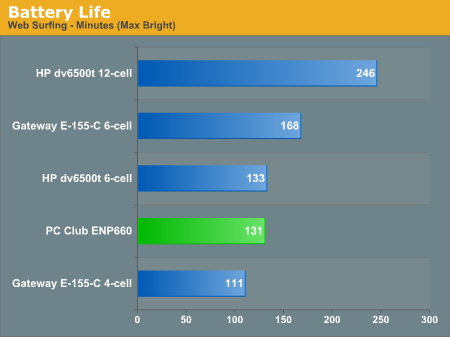
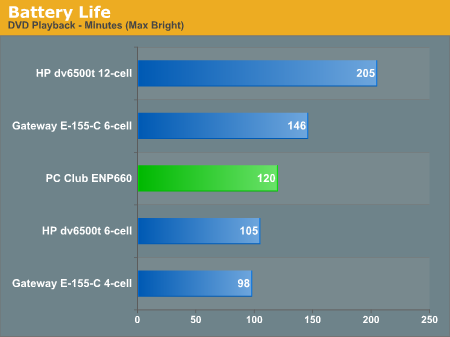
The performance is on par with the dv6500t with a 6-cell battery, but neither of those two laptops provides more than a couple hours of computing on a single charge. DVD playback tops out at two hours, so you will either need to get a larger battery, watch shorter movies, or else turn down the display brightness. We did run a second test of the web browsing script with the LCD at minimum brightness. That improved battery life to 164 minutes, or 25% more computing time. Using the LCD at the minimum brightness setting is not something we really cared for, however.
Power Consumption
Related to the battery life discussions we've just finished, we have power results. For power testing, we remove the battery from the laptops and measure system power draw at the wall outlet using a Kill-A-Watt device. We test several different scenarios to try to isolate the power draw of the various components. First, we have the baseline measurement when the system is idle and sitting at the desktop. No applications are running for 10 minutes or more but the screensaver and hard drive sleep mode are disabled. As a CPU load test, we run the SMP version of Folding@Home at 100%. Finally, for maximum power load we leave Folding@Home running and start 3DMark05. In this way, we can see roughly how much power the GPU is using in 3D mode versus 2D mode.
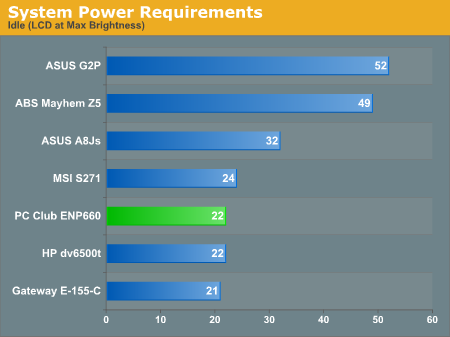
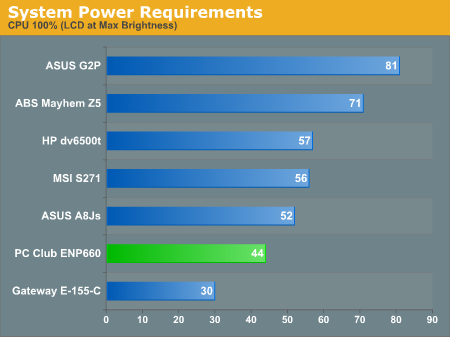
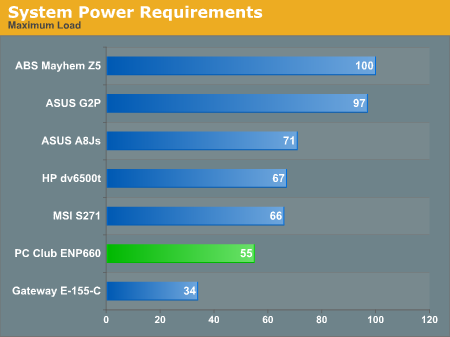
The power requirements are basically in line with the battery life results above. The faster processor in the HP dv6500t ends up using more power, but HP also comes with a slightly larger battery by default. Not shown in the above charts is the effect of reducing display brightness. That knocked off another 7W of power, so that at idle the ENP660 required only 15W while at maximum load it required 48W.
We find it interesting to consider some of the talk that's going around about reducing power requirements. Solid-state drives might help a bit, but those are only going to knock off at best 2W of power draw. We have heard it claimed that every watt of power saved can improve battery life by 30 minutes. That might be true if you're talking about a 15W notebook with a 100 WHr battery, but by our calculations a typical notebook (22W idle power draw with a 50 WHr battery) would need to cut 4W of power in order to improve battery life by 30 minutes.
The vast majority of battery life when a system is mostly idle is going to be consumed by the LCD backlight. We're hoping to take a look at some laptops that use LED backlighting in the near future, to see if those are able to offer significantly better battery life. That at least has a chance of reducing power requirements by several watts or more.
In the past, our standard battery life test has been provided courtesy of MobileMark 2005. Since we're now moving towards testing with Windows Vista (which MobileMark 2005 doesn't support), we needed to come up with a new method to determine battery life. Generally speaking, we don't expect people to seriously tax their laptops when they are unplugged, so we tried to create benchmarks that will approximate normal use.
For the first battery test, we use Internet Explorer to simulate surfing the web. We have a script that starts Internet Explorer and loads our three homepages, all of which contain quite a few Flash-based advertisements. The script then sleeps for 60 seconds, simulating "reading" a web page(s), after which Internet Explorer is shut down and reloaded. Internet Explorer is set to delete all temp files on exit, in order to continue to generate hard drive activity. The other battery life test is simply DVD playback, and we use Star Wars Return of the Jedi as our test DVD. Basically, the Internet Explorer test corresponds to about the best case scenario you are likely to encounter, while the DVD test is more taxing. Scores for all Vista equipped laptops are below, with the LCD is set to maximum brightness - the way we expect many people will use their notebooks.


The performance is on par with the dv6500t with a 6-cell battery, but neither of those two laptops provides more than a couple hours of computing on a single charge. DVD playback tops out at two hours, so you will either need to get a larger battery, watch shorter movies, or else turn down the display brightness. We did run a second test of the web browsing script with the LCD at minimum brightness. That improved battery life to 164 minutes, or 25% more computing time. Using the LCD at the minimum brightness setting is not something we really cared for, however.
Power Consumption
Related to the battery life discussions we've just finished, we have power results. For power testing, we remove the battery from the laptops and measure system power draw at the wall outlet using a Kill-A-Watt device. We test several different scenarios to try to isolate the power draw of the various components. First, we have the baseline measurement when the system is idle and sitting at the desktop. No applications are running for 10 minutes or more but the screensaver and hard drive sleep mode are disabled. As a CPU load test, we run the SMP version of Folding@Home at 100%. Finally, for maximum power load we leave Folding@Home running and start 3DMark05. In this way, we can see roughly how much power the GPU is using in 3D mode versus 2D mode.



The power requirements are basically in line with the battery life results above. The faster processor in the HP dv6500t ends up using more power, but HP also comes with a slightly larger battery by default. Not shown in the above charts is the effect of reducing display brightness. That knocked off another 7W of power, so that at idle the ENP660 required only 15W while at maximum load it required 48W.
We find it interesting to consider some of the talk that's going around about reducing power requirements. Solid-state drives might help a bit, but those are only going to knock off at best 2W of power draw. We have heard it claimed that every watt of power saved can improve battery life by 30 minutes. That might be true if you're talking about a 15W notebook with a 100 WHr battery, but by our calculations a typical notebook (22W idle power draw with a 50 WHr battery) would need to cut 4W of power in order to improve battery life by 30 minutes.
The vast majority of battery life when a system is mostly idle is going to be consumed by the LCD backlight. We're hoping to take a look at some laptops that use LED backlighting in the near future, to see if those are able to offer significantly better battery life. That at least has a chance of reducing power requirements by several watts or more.










11 Comments
View All Comments
Pol Newman - Wednesday, October 21, 2020 - link
You need an expensive laptop to study well